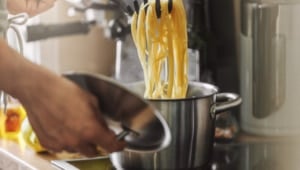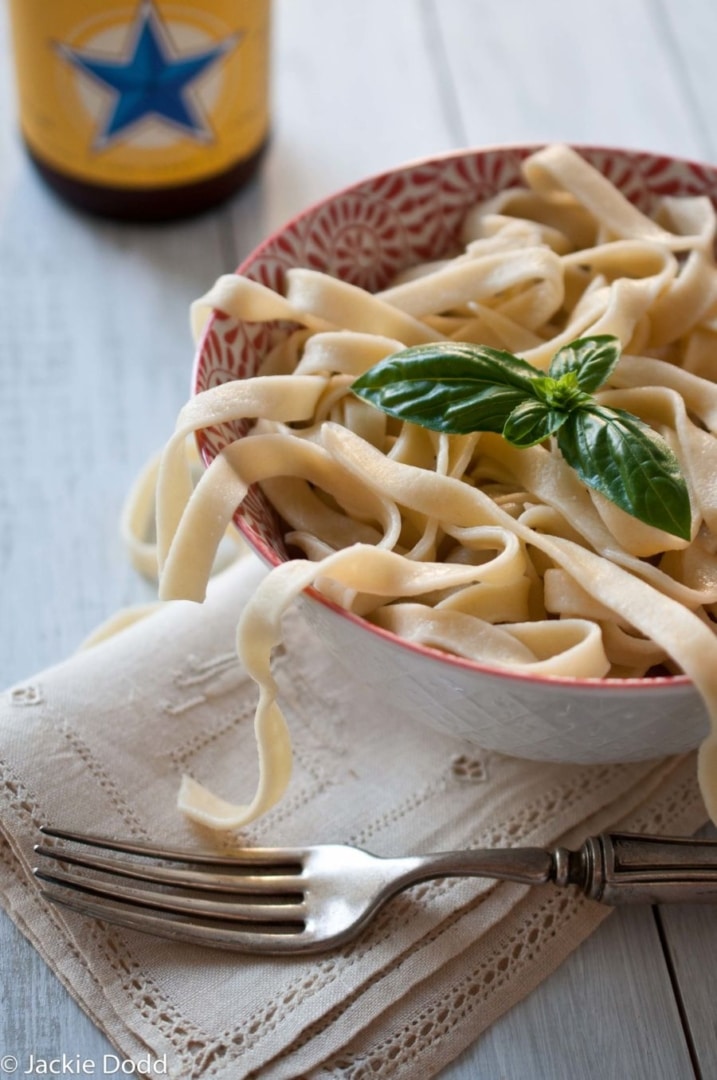How to Cook Pasta: 6 Dos & 4 Don’ts for your Perfect Spaghetti

Looking to perfect your pasta game? You’re in the right place. Get ready to discover the classic dos and don’ts of spaghetti preparation, as well as bust some myths and learn a few new facts that might surprise you.
In this guide, we’ll walk you through:
- The cooking times for pasta to make the perfect spaghetti
- Tips for cooking the best pasta and what pitfalls you should watch out for
- Alternative methods of cooking pasta that you can certainly try.
Let’s get cooking.
Cooking Time of Spaghetti: How to Make Your Pasta on Point

Cooking Time of Spaghetti
First things first: how long should you cook spaghetti to get a plate of firm and perfect pasta?
The answer actually depends on what type of pasta you’re cooking.
Fresh Pasta
It takes about three to five minutes to cook perfect fresh pasta in boiling water.
Cooking times will vary based on the size of the pasta, with thicker and bigger shapes taking longer than thinner smaller ones.
Pro Tip: You can tell when fresh pasta has finished cooking because it will float to the top of the water.
Dried Pasta
Dried pasta cooks for around eight to ten minutes.
Make sure to test a strand of your spaghetti to see if it’s done to your liking before taking the pot off of the heat.
Must-Dos for the Perfect Pasta
Aside from being mindful of the right cooking times, there are also plenty of other things that you can do to ensure that you’ll always have a perfect plate of pasta.
Use a Large Pot

Use a Large Pot
Using a big pot ensures that each strand of pasta gets cooked evenly, as they can freely circulate while boiling.
This makes for better-tasting pasta and also ensures that it doesn’t stick to the bottom or side of the pan (or to each other).
Try to get a pot with a well-fitting lid and keep this on while heating your water so that it boils faster. Remove the lid while the pasta is cooking so that you can tend to it.
Use Lots of Water

Use Lots of Water for your Spaghetti
Make sure to use at least 500 ml of water (roughly 2 cups) for every 100 grams of spaghetti.
However, even more water (up to double the amount) may make the cooking process easier, so opt for more if you have the pot space.
It’s important to use enough water for reasons similar to using a large pot: you want even cooking and no sticking.
Using a lot of water also means that you can fully submerge your spaghetti without breaking it.
Pro Tip: Placing a wooden spoon across the top of your pot will help prevent it from boiling over.
Just make sure to use wood (or heat-safe plastic) as metal utensils will get very hot in the steam, making them unsafe to touch and move.
Salt Your Water

Salt Your Water
It’s important to add salt to your pasta water, as the pasta will only absorb the salt and become seasoned when boiling, something that’s crucial for delicious spaghetti.
It’s best to just use table salt for this step—don’t waste your finishing salt.
You only need to add a few generous pinches of salt to your water; about 3/4 of a teaspoon per liter of water should be plenty.
If you use salt with larger crystals such as sea salt, add slightly more to account for the difference in compactness when measuring.
- Myth: Adding salt to your water will make it cook slower.
- Fact: Saltwater actually heats faster than freshwater.
Additionally, you should be adding your salt once the water is already boiling but before you add your pasta, so it shouldn’t matter too much anyway.
Adding the salt once the water is already boiling helps the salt dissolve faster, resulting in even distribution in the water and better absorption by your pasta.
If you add salt while the water is cold, you can also damage your pan over time as the coarse particles sink to the bottom of the pot and leave tiny scuffs.
Stir Your Pasta

Stir Your Pasta
Stirring your pasta helps it cook evenly and prevents it from clumping together.
Make sure to stir and constantly check the bottom of the pot for stubborn pieces, especially if you’re making do with a smaller pot.
You don’t have to sweat in the steam the whole time; simply stirring every few minutes will be sufficient.
With fresh pasta, be careful not to stir too early or too vigorously. This is because the spaghetti is more fragile and could lead to strands snapping. Stirring once halfway through will be fine as long as you keep an eye on it.
Test Doneness

A good time to start checking your pasta is around a minute before the earliest predicted cooking time.
Most pasta recipes call for the pasta to be al dente, which is Italian for “to the tooth”, but can be taken as “still having a bite to it”.
You want your pasta to be tender but also still have a little firmness and for each strand to hold its shape.
If you’re pre-cooking pasta to then use it in another step (such as in a sauce or casserole), you may want to cook it to slightly under al dente. In these cases, it should still taste slightly “chalky” to avoid overcooking it further down the line.
To test your spaghetti, carefully fish a strand out of the pot using a pasta spoon, tongs, or long-handled fork.
Be careful not to get splashed by the boiling water and wear an oven mitt if necessary. Blow on the pasta or run it gently under cold water to cool it down before tasting.
Fun Fact: The hole in the middle of a pasta spoon (or spaghetti server) not only helps the spoon stir through the water more smoothly but also works as a measurement device.
The amount of dried spaghetti that fits through the hole is approximately one serving.
Let It Rest

This period allows the pasta to steam slightly, giving it a softer texture. It also allows the pasta to dry off for a bit.
Dry pasta absorbs fats such as oil or butter better than wet pasta. Further, it also adheres to sauces better.
The water remaining on still-wet pasta can act as a barrier, causing the sauce to slip off the spaghetti.
However, it doesn’t have to be perfect.
While it’s a good idea to let your pasta rest, a few hidden drops of water aren’t going to ruin anything, so there’s no need to run around with a hair drier.
A good indicator for “dry enough” is when your pasta looks mostly matte rather than shiny.
Don’ts for Cooking Pasta: 4 Most Common Mistakes When Making Spaghetti
When making spaghetti, here are several things that you should avoid doing.
Rinse

Don’t rinse your Spaghetti
There’s no need to rinse your spaghetti. The starch on the outside of the pasta is what helps the sauce stick to it, so don’t wash it away.
If you are worried about overcooking your pasta, simply adjust your cooking time.
The times provided on the box and here are, again, only guidelines. Don’t be afraid to experiment with cooking times if the box’s instructions aren’t working for you.
The only time you should rinse your pasta is if you plan on eating it as a component of a cold dish such as pasta salad.
Pasta salad is not traditionally made with spaghetti, but no judgment here.
Break the Pasta

Don’t: Break the Pasta
While it might be tempting to snap your spaghetti in half to fit it in the pot all at once, this is a big faux pas.
Keeping the pasta long makes it easier and tastier to eat. It’s more difficult to swirl shorter strands onto your fork, and they tend to be less coated with sauce.
Instead, simply put the spaghetti into the pot whole (it’s okay if a little bit sticks out at the top). After a minute or two, the submerged portion of the pasta will soften, allowing you to bend it into the pot completely by nudging it with your spoon.
In Italy, it is considered bad luck to break your spaghetti in half (or offensive, at the very least).
Another spaghetti sin to avoid if you’re keeping it authentic is using a spoon to twirl your pasta with. The proper way is to use a fork, and you should only twirl the pasta at the side of your plate or bowl.
Oil the Water

Don’t: Oil the Water
A common cooking myth is that you need to add oil to your pasta water to prevent it from sticking together.
This isn’t necessary.
As oil and water don’t mix, the oil stays on the surface of your pot as it boils, with little of it reaching the pasta at all.
As you drain your spaghetti, the oil will end up coating the pasta as it comes out.
This leads to greasy pasta that sauces will slide right off of, while at the same time doing nothing to prevent clumping while boiling.
As long as you don’t overcrowd your pot and stir occasionally, there’s little risk of your pasta sticking together.
Throw Away All the Pasta Water

Don’t: Throw Away All the Pasta Water
While you might be eager to start eating once your pasta has finished boiling, make sure that all of the pasta water doesn’t go down the drain.
Instead, reserve some by scooping up a cup full from the pot, or by using tongs to move your spaghetti into the colander rather than pouring it.
Why? Because pasta water is an amazing and versatile ingredient.
Add some to your sauce to thin it out and help it stick perfectly to your spaghetti while making it silky smooth at the same time.
You can even use it as the base for a sauce itself. For classics like cacio e pepe or carbonara, the pasta water is key in binding simple flavors and ingredients to delicious pasta.
Got a green thumb? Pasta water is also full of healthy starches that are great for your plants. Once you’re done using it for cooking (and it has cooled down to room temperature), try using the remainder to water your indoor or outdoor plants.
Other Ways of Cooking Pasta and What to Pay Attention To
While you might be reading this for tips on traditional Italian-style spaghetti preparation, sometimes you just want to have a delicious plate of pasta in a pinch.
If you’re not able to prepare your meal on the stove, you can still make tasty pasta with these methods:
Cooking Pasta in the Microwave

Just put your serving of spaghetti in a microwave-safe bowl, cover it with as much water as space will allow, and pop it in the microwave.
We recommend adding three minutes to the recommended cooking time of the pasta box if you use cold water, or the recommended time if you use boiling water.
For spaghetti, remove the bowl after a minute or two to get the pasta fully in the bowl. Alternatively, you can break the strands if you absolutely must.
Make sure to check the pasta for doneness the same way you would on a stovetop, popping it back in for 30-second to 1-minute intervals until it’s al dente.
Cooking Pasta in the Oven

Cooking Pasta in the Oven
You can also prepare spaghetti in the oven.
For plain pasta, simply preheat your oven to 100ºC (212ºF), cover the pasta with water, and cook for the recommended time plus 10 minutes. Then, taste your pasta and either take it out and drain it or cook it longer if needed.
If you’ve got an oven at your disposal and some other ingredients on hand, why not try a pasta bake?
We recommend preheating your oven to 190ºC (375ºF), then putting your uncooked pasta into a baking dish and combining it with marinara sauce, water, vegetables, and seasoning. Top the mixture with cheese and then bake for 45–50 minutes.
This super simple method results in a comforting and classic pasta bake with no boiling or stovetop required.
Cooking Pasta in an Instant Pot

However, we do have to break some pasta “don’ts” for this one, so apologies in advance for any traditional pasta preparers.
To make pasta in an instant pot, simply break your spaghetti in half and add water and a few tablespoons of olive oil.
Then pressure cook on high for half the recommended cooking time (approximately four minutes), and let it depressurize naturally for the following ten minutes.
There are also tons of ways to prepare your whole meal in your instant pot, so be sure to play around with different recipes and ingredients.
The Bottom Line
There’s a lot to consider when preparing pasta, but it’s certainly worth it for such a delicious dish.
Follow the above guidelines for the basics, but don’t be afraid to experiment to perfect your own spaghetti cooking method.



